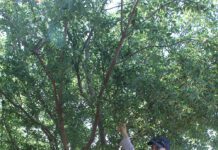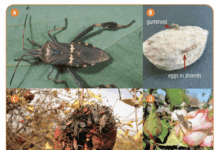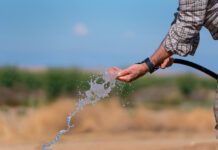To meet increasing demand for reduced water consumption, California almond growers know efficiency in irrigation practices must improve. One of the improvement avenues identified by research is a more precise method of assessing tree stress. As a three-year study of thermal imagery continues, researchers aim to develop a method that will use inexpensive thermal imagery to evaluate tree water needs and help growers with management decisions.
Research
Work funded by the Almond Board of California (ABC) and lead by Brian Bailey of the University of California (UC) Davis Plant Sciences Department showed that using a forward-looking infrared radar device (FLIR) on an iPhone or Android can deliver adequate image resolution and spectral range providing the first step toward a goal of developing a quick and inexpensive tool to evaluate tree water needs in order to guide irrigation decisions.
Their objectives in this research were to develop a model for evapotranspiration inversion from thermographic imagery, to collect validation data for model calibration, validation and testing and to develop a smartphone application for distribution.
Thermal Imaging Cameras
Thermal imaging cameras are actually sensors that make photos from heat, not visible light—like most other cameras. Heat, also called infrared or thermal energy, and light are both parts of the electromagnetic spectrum, but a camera that can detect visible light won’t see thermal energy and a thermal imaging camera (sensor) won’t detect visible light.
Thermal cameras can detect more than heat, they can detect tiny differences in heat, as small as 0.01 degree Celsius (C) and display them as shade of colors. FLIRs can detect these color differences and translate them into image detail. When two objects next to one another have even subtly different heat levels, they show up clearly to an FLIR regardless of light conditions. FLIRs detect temperature differences and translate them into image detail.
The FLIR One Pro is a lower cost alternative at $399 that delivers 160 by 120 resolution, a spectral range of 8-14 micrometers and operates with an iOS or Android. The accuracy of the FLIR One Pro camera was assessed by comparing the temperature measured by the camera with that of a thermocouple pressed against the leaf surface.
Assessing Water Status
Dr. Bailey, outlined the ABC funded research in thermal imagery for assessing water status at the 2018 Almond Conference. Goal of the research was to investigate thermal imagery as a low cost and low time water status measurement method and develop a means for rapidly measuring spatial variability in water status.
Dr. Saa, Senior Research Manager of ABC, explained that water lost by the leaf in transpiration creates a cooling effect and can reduce the leaf temperature to several degrees below the ambient air temperature in the case of a well-watered tree. As trees deplete their water source, transpiration begins to decline and the temperature range between the leaf and the air temperature is reduced.
The challenge in using that temperature as a basis for an irrigation decision, Saa said, is that transpiration can be affected by many factors different from temperature. Other factors include weather, sunlight, air temperature, humidity and plant health.
“We need more information than just the temperature to make irrigation decisions, and that is why Dr. Bailey’s research is relevant,” Saa said. What Dr. Bailey and his collaborators are seeking is a model for using the leaf temperature that also calibrates other data.
To develop that approach, a group of measurements were collected for a number of both shaded and sunlit almond tree leaves.
Thermal images were obtained from leaves with the FLIR smartphone camera to provide the spatial distribution of surface temperatures across the leaf, forming the basis of the measurement technique. Minimum and maximum possible leaf temperatures that could exist given current weather conditions were determined by placing reference leaves within the image of the leaf of interest. To measure the minimum possible leaf temperature, a leaf was sprayed on both sides with water about one minute prior to measurement of its temperature. The maximum possible leaf temperature was obtained by covering a leaf with petroleum jelly on both sides.
Non-leaf reference surfaces were also placed in the image of the leaf of interest to determine if they could effectively predict the dry leaf temperature of the ambient air temperature. Reference surfaces considered are white, green and black paper.
After the pictures were taken, the stem water potential of the leaf are measured using a pressure chamber. Maximum stomatal conductance and photosynthesis rate were also measured.
Challenges to This Technology
As pointed out earlier, the challenge with this technology is that the temperature of a leaf is influenced by many other factors besides how much water a tree receives. Those factors include weather, sunlight, air temperature and humidity. The cost of the camera can also be a limiting factor in adoption, along with speed of relaying information. Dr. Bailey’s report said one aim of the study was to determine if a smartphone based thermal camera that can be purchased for around $200 can assist with guiding efficient irrigation practices.
In Conclusion
The ABC research report concludes that the FLIR One Pro smartphone thermal camera appears sensitive and precise enough to detect topical differences in leaf surface temperature created by varying irrigation treatments. It does not appear accurate enough to consistently compare the thermal temperatures with other independent measures of temperature such as through a nearby weather station or other handheld temperature sensor. The report determined that thermal images must be calibrated against other measured temperatures within a given image. The approach moving forward for measurement of individual leaves will be to primarily consider shaded leaves placed on a sheet of black paper. Shaded leaves appear preferable, because thermal temperatures are more consistent, yet the effect of water treatment is still discernible.
The black background allows for easy separation between the background and leaf surfaces in the thermal images. Strong correlations were observed between the temperature of green paper and the dry leaf temperature, allowing use of the temperature of the shaded green paper in the image to calibrate actual transpiring leaf temperature against that of a dry non-transpiring leaf.












